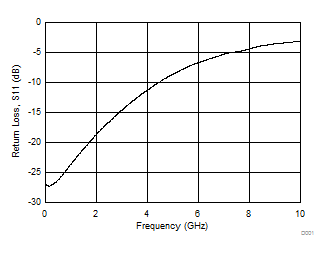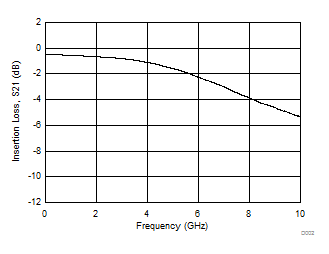ZHCSEC8 November 2015 HD3SS3411
PRODUCTION DATA.
6 Specifications
6.1 Absolute Maximum Ratings(1)
Over operating free-air temperature range (unless otherwise noted)| MIN | MAX | UNIT | ||
|---|---|---|---|---|
| Supply voltage range (VCC) | Absolute minimum/maximum supply voltage range | –0.5 | 4 | V |
| Voltage range | Differential I/O | –0.5 | 2.5 | V |
| Control pin | –0.5 | VDD + 0.5 | ||
(1) Stresses beyond those listed under absolute maximum ratings may cause permanent damage to the device. These are stress ratings only and functional operation of the device at these or any conditions beyond those indicated under recommended operating conditions is not implied. Exposure to absolute-maximum-rated conditions for extended periods may affect device reliability.
6.2 ESD Ratings
| VALUE | UNIT | ||||
|---|---|---|---|---|---|
| V(ESD) | Electrostatic discharge | Human-body model (HBM), per AEC Q100-002(1) | ±2000 | V | |
| Charged-device model (CDM), per AEC Q100-011 | ±500 | ||||
(1) AEC Q100-002 indicates that HBM stressing shall be in accordance with the ANSI/ESDA/JEDEC JS-001 specification.
6.3 Recommended Operating Conditions
over operating free-air temperature range (unless otherwise noted)| MIN | NOM | MAX | UNIT | |||
|---|---|---|---|---|---|---|
| VCC | Supply voltage | 3 | 3.6 | V | ||
| VIH | Input high voltage (SEL, OEn Pin) | 2 | VCC | V | ||
| VIL | Input low voltage (SEL OEn Pin) | –0.1 | 0.8 | V | ||
| VDiff | High speed signal pins differential voltage | 0 | 1.8 | VPP | ||
| VCM | Common mode voltage (differential pins) | 0 | 2 | V | ||
| TA | Operating free-air temperature | –40 | 105 | °C | ||
6.4 Thermal Information
| THERMAL METRIC(1) | HD3SS3411 | UNIT | |
|---|---|---|---|
| RWA (WQFN) | |||
| 14 PINS | |||
| RθJA | Junction-to-ambient thermal resistance | 50.5 | °C/W |
| RθJC(top) | Junction-to-case (top) thermal resistance | 63.1 | |
| RθJB | Junction-to-board thermal resistance | 26.4 | |
| ψJT | Junction-to-top characterization parameter | 2.2 | |
| ψJB | Junction-to-board characterization parameter | 26.5 | |
| RθJC(bot) | Junction-to-case (bottom) thermal resistance | 7.3 | |
(1) For more information about traditional and new thermal metrics, see the IC Package Thermal Metrics application report, SPRA953.
6.5 Electrical Characteristics
over operating free-air temperature range (unless otherwise noted)| PARAMETER | TEST CONDITIONS | MIN | TYP | MAX | UNITS | |
|---|---|---|---|---|---|---|
| ICC | Device active Current | VCC = 3.3 V, OEn = 0 | 0.6 | 0.8 | mA | |
| ISTDN | Device shutdown Current | VCC = 3.3 V, OEn = 0 | 0.3 | 0.6 | µA | |
| CON | Outputs ON Capacitance | 0.6 | pF | |||
| RON | Output ON resistance | VCC = 3.3 V; VCM = 0 V to 2 V ; IO = –8 mA |
5 | 8 | Ω | |
| ΔRON | On resistance match between pairs of the same channel | VCC = 3.3 V ; –0.35 V ≤ VIN ≤ 2.35 V; IO = –8 mA |
0.5 | Ω | ||
| R(FLAT_ON) | On resistance flatness (RON(MAX) – RON(MAIN) |
VDD = 3.3 V; –0.35 V ≤ VIN ≤ 2.35 V | 1 | Ω | ||
| IIH(CTRL) | Input high current, control pins (SEL, OEn) |
1 | µA | |||
| IIL(CTRL) | Input low current, control pins (SEL, OEn) |
1 | µA | |||
| IIH(HS) | Input high current, high speed pins | [A/B/C][p/n] VIN = 2 V for selected port, A and B with SEL= 0, and A and C with SEL = VCC | 1 | µA | ||
| [A/B/C][p/n] VIN = 2 V for non-selected port, C with SEL= 0, and B with SEL = VCC (Note there is a 20 KΩ pull-down in non-selected port) |
100 | 140 | µA | |||
| IIL(HS) | Input low current, high speed pins | [A/B/C][p/n] | 1 | µA | ||
| High Speed Performance | ||||||
| IL | Differential Insertion Loss | f = 0.3 MHz | –0.5 | dB | ||
| f = 2.5 GHz | –0.7 | |||||
| f = 4 GHz | –1.1 | |||||
| BW | -3 dB Bandwidth | 7.5 | GHz | |||
| RL | Differential return loss | f = 0.3 MHz | –26.4 | dB | ||
| f = 2.5 GHz | –16.6 | |||||
| f = 4 GHz | –11.3 | |||||
| OI | Differential OFF isolation | f = 0.3 MHz | –75 | dB | ||
| f = 2.5 GHz | –22 | |||||
| f = 4 GHz | –19 | |||||
| Xtalk | Differential Crosstalk | f = 4 GHz | –35 | dB | ||
6.6 Timing Requirements
| MIN | NOM | MAX | UNIT | ||
|---|---|---|---|---|---|
| tPD | Switch propagation delay | 80 | ps | ||
| tSW | Switching time | 0.5 | ns | ||
| tSK_INTRA | Intra-pair output skew | 5 | ps | ||
6.7 Typical Characteristics

